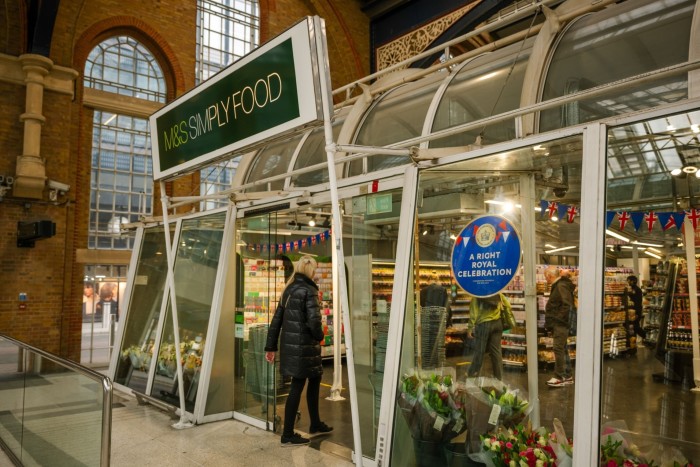“Retailers are eternally dissatisfied people,” said Peter Ruis, the well-respected retail executive who recently returned to the John Lewis team to help revamp its department stores, this week. The remarks are an echo of those by Marks and Spencer’s chief executive Stuart Machin, who has described his team as “always positively dissatisfied”.
Both were referring to their respective turnaround progress at the two shopping bastions of Middle England.
In some fundamental ways the pair are dissimilar, with M&S — judged by analysts to have done a good job in boosting its desirability and profits in recent years — having a greater number of stores and being subject to the shareholder scrutiny that goes with being a listed company. Meanwhile, the John Lewis Partnership, which also owns supermarket chain Waitrose, remains in the middle of its own difficult turnaround, with its employee-ownership structure limiting its financing options.
But both high-street names are in the same fight: competing for reasonably well-off consumers in the premium grocery market as well as in fashion and homeware, with cash-conscious shoppers tempted by discount and online rivals.
They are also both experiencing a degree of leadership upheaval, with Dame Sharon White stepping down as chair of John Lewis next year, or as soon as a replacement is found. Meanwhile, at M&S, co-chief executive, Katie Bickerstaffe, who oversaw the group’s digital, data and technology operations, will step down in July after less than two years to pursue other board roles.
John Lewis turned a corner this week, reporting that it is back in the black with a pre-tax profit of £56mn in the year to January — after three years of losses — although getting the business to this point has been challenging.
The group’s executives have promised to “unashamedly” focus on retail, in a move away from an earlier strategy that emphasised its financial services and build-to-rent divisions. John Lewis has now scrapped targets to derive almost half of its earnings from outside retail by 2030. But it retained a pre-tax profit target of £400mn by 2027-28.
“Returning to profit is encouraging, and I think that they desperately need to have the resources to invest more in the business because it has become competitively weak over recent years in a number of key areas,” said Richard Hyman, a retail analyst at Thought Provoking Consulting. “They are addressing that, that’s very welcome.”
M&S, meanwhile, has been reaping the fruit of a revival plan meticulously executed by Machin in recent years, which catapulted it back into the FTSE 100 last year as its recovery picked up pace. Its share price rallied 121 per cent in 2023.
In a further sign that M&S has got its mojo back, it is now neck and neck with Waitrose, with an equal share of the UK grocery market of 3.8 per cent, according to data provider NIQ, after Waitrose had the upper hand for years.
“Waitrose has lost a little market share . . . [but] in the most recent period, we’ve started regaining overall market share, so that pendulum has swung,” said James Bailey, who runs Waitrose, on Thursday.

He plans to open the first new Waitrose supermarkets in almost a decade, adding to its 329 shops, and refurbish 80 existing ones after not being in a position to meaningfully invest before. The partnership plans to inject more than £2.4bn over the next four years into its operations, funded by internally generated cash flow.
Although M&S, which only recently restarted paying dividends, has been closing less profitable or productive full-line stores that sold clothing and home and food since 2017, it opened more of its popular food shops, going from 253 grocery sites six years ago to 319 now.
“You’ve got the two biggest beasts in the middle market, you’d be forgiven for thinking they can’t both do well [in food] at the same time, or can they?” said Hyman.
Waitrose is stronger in the south, while M&S’s roots are firmly planted in the north. “We quite like what they do, but in terms of competing they’re not as important to us as Sainsbury’s and Aldi,” a senior M&S employee said.
When it comes to clothing and homeware, operationally there are more differences than similarities between the two, analysts believe, although both target wealthier customers.
John Lewis has 34 department stores, sells a range of mid to upper-range fashion brands such as Jigsaw and Whistles, and relies heavily on technology and furniture and furnishings to bolster its top line.
M&S operates 244 full-line stores, with plans to cut them to 180 by 2028, and it mostly sells own-brand clothes — although it has been adding more third-party labels and has dropped its dowdy ranges to lure younger shoppers.
John Lewis’s department stores posted a 4 per cent sales decline to £4.8bn last year, indicating that the second half was challenging, which was “reflective of consumers seeking to do Christmas on a tighter budget by trading down from mid-market players”, said analysts at GlobalData.
Fashion sales, including beauty, were up year on year, but it posted weaker trading in its home and technology divisions. By contrast clothing and home sales in M&S’s most recent quarter grew 4.8 per cent, ahead of the market.
In terms of competitors in clothing, for M&S shoppers the biggest overlaps are with Primark and Next, according to analysts at Redburn Atlantic. Primark is the market leader by volume and Next is a close number two to M&S by value, they added.
Next has been scooping up brands in recent years including Joules and taking a majority stake in Reiss and also sells labels including River Island and Barbour.
Hyman added: “Next is in the middle, it’s just a juggernaut, and very robust and won’t give up any ground. You can be certain they will look to increase market share in the middle. M&S and John Lewis, they will have to run faster.”
M&S cannot afford distractions. “Whilst we believe there is further upside, the easy money from the [profit] margin recovery story has already been made,” said Kate Calvert at Investec.

But in recent weeks it has had to contend with the news that Ocado was threatening litigation as the two retailers clash over a final payment tied to their online joint venture.
Ocado’s move was unexpected, the senior employee said. M&S previously said: “Our advice is that the financial performance of Ocado Retail means the criteria for the performance payment was not met.”
Although both groups are experiencing leadership change there is continuity, with John Lewis chief executive Nish Kankiwala, who was appointed last year, staying in his role as well as Machin, who has been CEO for almost two years and is regarded as a hard-charging boss, according to people who have worked with him.
Bickerstaffe’s departure had been planned, in a way, since she agreed to become co-chief executive in 2022. A seasoned leader with experience of the public markets, she was a non-executive at M&S when chair Archie Norman first asked her if she would move into an executive role in 2020. She agreed to stay on for a transition period until the turnaround gathered pace, while retaining non-executive roles at housebuilder Barratt Developments and the England and Wales Cricket Board.
M&S’s transformation is now predicated on growing sales profitably having “fixed the basics”, while John Lewis’s is only just starting in earnest, with a renewed focus on getting its retail offering right.
“Next, M&S and John Lewis — you wouldn’t want to be in that [middle] market and not be one of those brands, but can they all do well at the same time? asked Hyman. “They’re addressing the same customers.”











